Having ants in your kitchen can be a real headache, especially when you realize that the one or two ants you see scurrying across the kitchen counter or munching on a crumb are just a small sign of an even bigger problem!
So, how to get rid of ants in the kitchen? Throw away contaminated food items, double check food packaging and containers, throw garbage out regularly, wipe down kitchen surfaces, set up ant baits, and more!
We’ll discuss these strategies more thoroughly later in the article. First, it’s crucial to understand how and why ants have gotten into your kitchen first, so you can prevent the problem from happening again! Let’s start!
What Attracts Ants in the Kitchen? Why Do I Have Ants in My Kitchen?
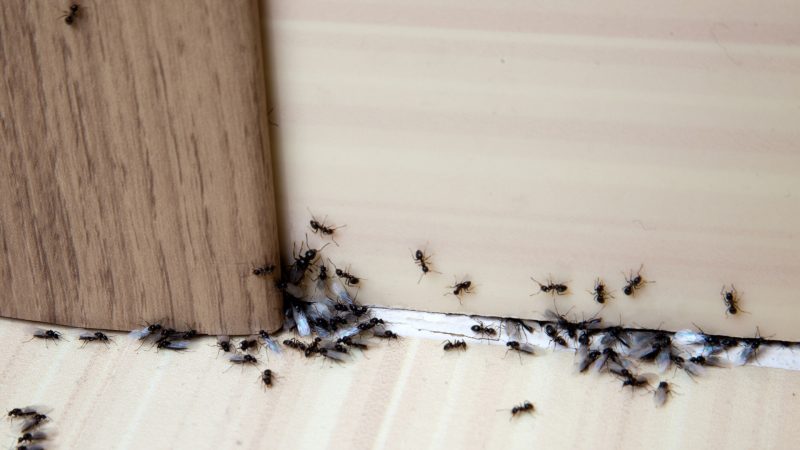
Ants will wander through your kitchen for one reason only—and that is to find food. Ants are foraging animals and will eat both plant and animal-based food items. Once they have located a food source, they leave behind a chemical trail of pheromones which will help other colony members find your food.
Related: What Do Ants Eat? | Ant Feeding Habits
How to Get Rid of Ants in the Kitchen – Step by Step Instructions
1. Inspect the Food on Your Counters, Pantries, Cabinets, and Drawers
If you see them on your food or suspect they have already crawled on it, throw it away. Ants can transmit diseases and bacteria like E. coli and salmonella, so it’s better to be safe than sorry. For food that was already sealed properly, wipe down the remaining food packaging or jars and set them aside.
2. Remove All Garbage From Your Kitchen and Wipe Down Garbage Cans
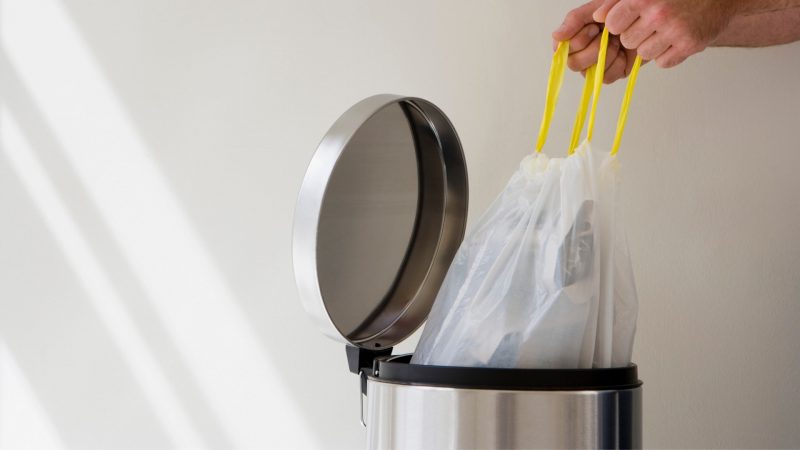
Tie up garbage bags, clean up the trash lying around, and take the trash outside. Ants are attracted to food residue and scents in the garbage can. Cleaning your trash cans regularly will remove any traces of food that could lure them in.
3. Wipe Down Your Countertops, Sink, Floors and Other Kitchen Surfaces
Use a 1:1 solution of water and white vinegar. Pour the solution into a bottle, spray on kitchen surfaces, then wipe down using a dry cloth. The scent of vinegar repels ants and erases their pheromone trails.
4. Set up Ant Baits
Ant baits can be found at your local hardware store and some pharmacies. Ant baits contain substances that will smell good to ants but are actually toxic. They will slowly bring small pieces of the bait back to their nest to share with other ants, eventually wiping out the entire colony.
- ATTRACTS & KILLS: Effectively targets and eliminates common...
- KILLS THE ANTS YOU DON'T SEE: Terro ant bait is designed to share...
- FAST-ACTING: Noticeable ant activity reduction within days as...
- READY TO USE: Simply place ant baits indoors with no setup...
- VERSATILE HOME PLACEMENT: Ideal for use as terro ant traps along...
- One 8 count package of Raid Ant Killer Baits protects against...
- Raid Ant Killer works for up to 3 months to help control ants in...
- This pest killer comes in convenient Raid Ant Traps where ants...
- Raid Ant Killer is ideal for use throughout your home, including...
- Try other Raid bug spray and insect killer products for all of...
- EFFECTIVE ANT ELIMINATION: Terro outdoor liquid ant baits attract...
- COLONY CONTROL: Worker ants carry Terro ant bait back to the...
- FAST-ACTING RESULTS: With the use of Terro ant killer, experience...
- SIMPLE SETUP: Terro outdoor ant bait is easy to use with insert...
- OUTDOOR PROTECTION: Place Terro ant bait stations outdoors to...
In extreme cases (i.e., severe infestations), applying ant sprays and foggers may be necessary to defeat these pesky bugs. Several natural products can kill ants and help keep them from coming back.
Different Types of Ants in the Kitchen
Identifying the ant species present in your kitchen is an essential step so that you can tailor your control methods based on their food preferences and nesting sites. Here are the most common ants found in kitchens:
Thief Ant
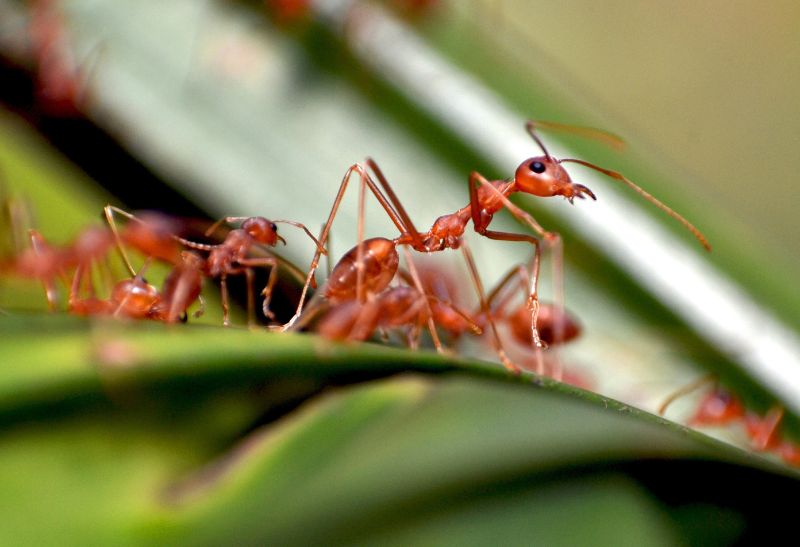
- Identification: Worker ants are 1/16 inch in size and brownish orange in color
- Nesting site: Microhabitats found in the kitchen pantry or around human structures
- Food preference: Food with protein or grease
- Signs of damage: Usually goes unnoticed due to extremely small size unless they are found in food items or are against a light background
Odorous House Ant
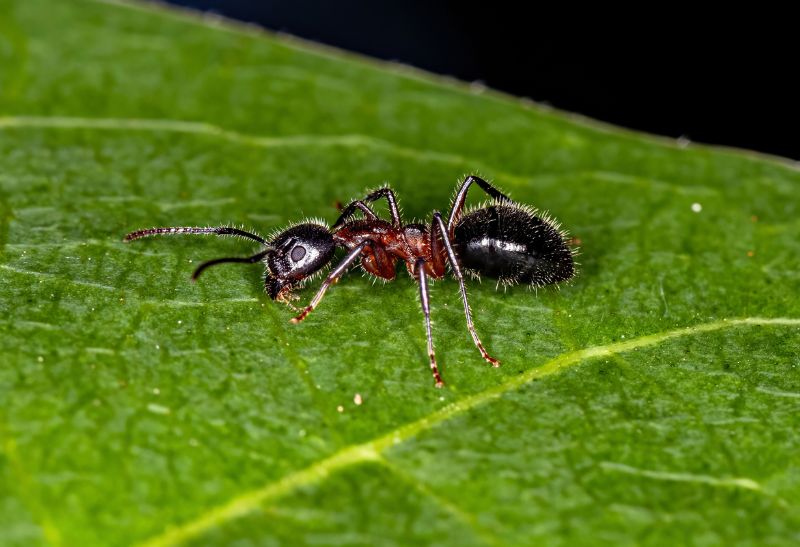
- Identification: Worker ants are 1/8 inch in size, black in color, and can emit a foul odor similar to blue cheese or rotten coconut when crushed
- Nesting site: In appliances or under sinks
- Food preference: Sugary food, especially those in liquid form
- Signs of damage: Well-defined trails that connect outdoors and enters through cracks and openings in kitchens
Pharaoh Ant
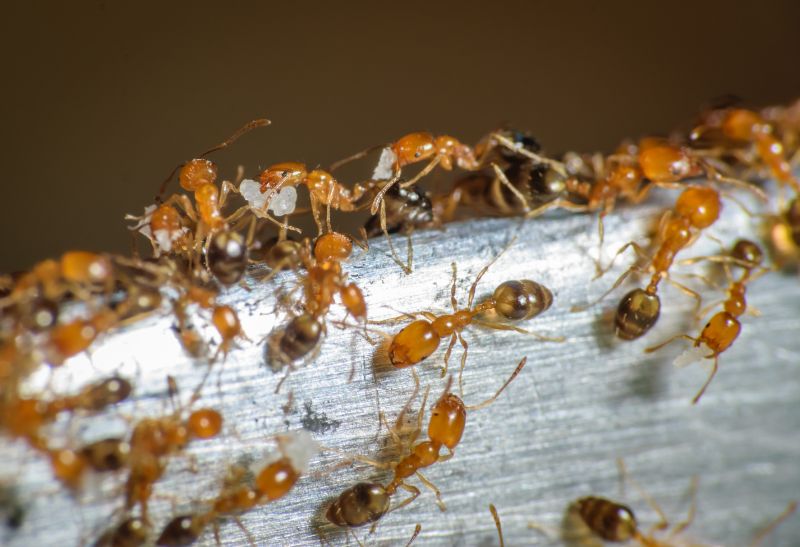
- Identification: Workers are 1.5 to 2 millimeters in length, light brown or red or yellowish in color, and have sparse hairs on the body
- Nesting site: Under appliances or carpets, behind walls, and in trash
- Food preference: Sweet, fatty, or oily food
- Signs of damage: Trails or large accumulations of the ants themselves around food items in the kitchen
Pavement Ant
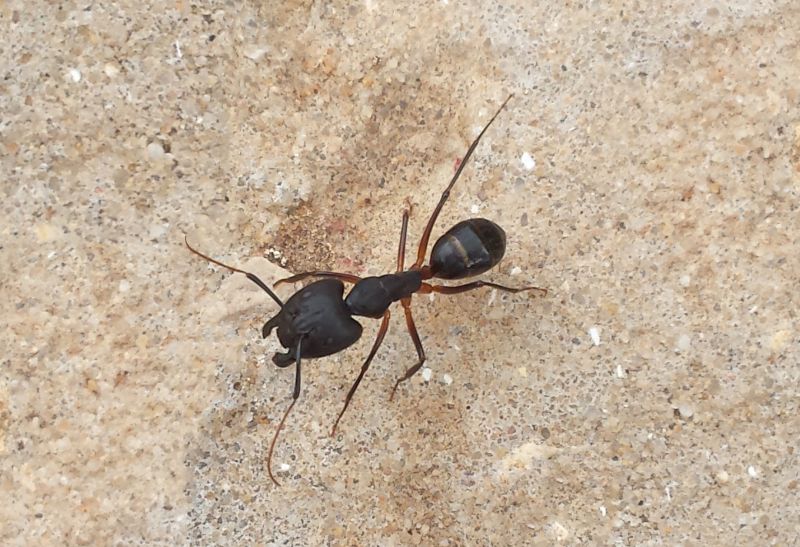
- Identification: Worker ants are 1/8 inch in size, dark brown in color, and have a retractable stinger
- Nesting site: Under carpets and toilets; in trash, insulation, and wall voids; near baseboards, food crumbs, and sinks
- Food preference: Sweet and greasy food
- Signs of damage: Damage to foundations (can cause unevenness, cracking, or crumbling)
Related: How Many Types of Ants Are There: Ant Identification Chart
How to Get Rid of Tiny Ants in Kitchen
If we’re talking about tiny ants, you are likely dealing with pharaoh ants. Management of this species is usually difficult as they have inaccessible nesting sites. Treatment usually includes baits labeled for indoor ant control.
Non-repellent baits are recommended and should be placed in pharaoh ant trails. The ants will transport the bait back to their colonies and kills the entire colony. However, this process may take several weeks or months, depending on the colony size.
How to Get Rid of Sugar Ants in Kitchen
These sugar ants that many people refer to are actually pavement ants. To get rid of these ants, simply wipe up their trails using dish soap applied on a wet rag. A boric acid bait can also be used.
These methods may need to be repeated until all ants and their activities are completely eliminated. Expect effectiveness to kick in within 1 to 7 days. Protection usually lasts until the succeeding spring season.
How to Get Rid of Black Ants in Kitchen
Also referred to as black garden ants, black ants are usually swarming in homes from June to July. Treatment of black ants require the same procedure as the previous types of ants: wiping them down and placing suitable baits.
How to Get Rid of Pavement Ants in Kitchen
As mentioned earlier, pavement ants can be removed from kitchens by using dish soap to wipe their pheromone trails then using a bait to kill the entire colony.
Ants in Specific Places in the Kitchen: What Should You Do?
Once ants have invaded your kitchen, you can find them just about anywhere. Let’s look at some familiar places where you might find ants and what you can do about it.
Ants in Kitchen Sink

If you have ants in the kitchen sink, they are likely attracted to the moisture or any leftover food residue in your sink or on dirty dishes left there. Most probably, they would also be in your drain and dishwasher.
To take care of this problem, mix one part dish soap with three parts water in a bottle, and spray it all over the kitchen sink. Not only does this kill the ants but it also cleans your sink of any food residue.
After you’ve done that, dump about a tablespoon of baking soda down your drain, followed by a cup of vinegar. After waiting about 15 minutes, dump a pot of boiling water down the drain. This kills any ants left alive and also helps make your drain squeaky clean!
Ants on Kitchen Counter
You can help eliminate ants on your kitchen counter using a 50/50 water and white vinegar solution. Vinegar repels the ants and removes their pheromone trails. You can also use the dish soap/water solution to clean your countertops and kill ants.
Ants in Kitchen Cupboards
If the ants have come in direct contact with the food stored in your kitchen cupboard, throw it away, and seal up any remaining food. It’s best to avoid any risk of contamination as much as possible.
Afterward, remove all items from your cupboard so that you can clean them properly. Wipe down all surfaces (including cupboard doors and walls) with the water and vinegar solution and ensure no crumbs or sticky messes are left behind.
Ants Under Kitchen Sink
Ants found under your kitchen sink are likely attracted to the moisture from a leaky pipe or if you store your garbage under your sink to any leftover food. Remember, even just a few crumbs stuck to a discarded wrapper can be enough to attract ants.
Wipe the area down with the water and vinegar solution from earlier. Next, check for any leaking pipes that may be providing the ants with a source of water. Dry the area thoroughly and take out your garbage regularly.
Home Remedies for Ants in Kitchen | Natural Way to Kill Ants in Kitchen
1. One Part Dish Soap to Three Parts Water
Mix one part dish soap to three parts water into a spray bottle, and spray it directly on any ants you find. The soapy water suffocates the ants by clinging to their exoskeletons, and at the same time, you will be cleaning the surface, making it less likely to attract more ants.
2. Chalk and Baby Powder
It isn’t known exactly why ants avoid these products, but they are effective for repelling ants! Draw a line with chalk or sprinkle baby powder wherever ants traverse your home. This includes ant trails and entry points.
3. Cinnamon
Cinnamon is probably already in your kitchen. It smells great and isn’t expensive. Surprisingly, it can also repel ants! Sprinkle it directly on the ants or along their trails.
4. Diatomaceous Earth
The name sounds intimidating, but diatomaceous earth is an all-natural and effective solution for many bug problems. It is an organic powder made from the fossils of tiny sea-dwelling organisms and works by drying ants out, ultimately killing them.
- Natural Product - Composed of 2lbs of 100% ground freshwater...
- OMRI Listed - Listed with the Organic Minerals Research...
- Powder Duster Included - Powder duster in the bag for easy and...
- Supports a Great Cause - Harris donates 10% of profits to support...
- Made in the USA – Mined in Nevada and packaged in Georgia
Sprinkle the product wherever you see ants. But use caution to avoid too much of the product becoming airborne. If inhaled, it can cause lung irritation, so be careful around children and pets, and use a mask for yourself during application.
How to Prevent Ants in Kitchen: Tips and Guide
After knowing how to get rid of ants in various places in your kitchen, it’s important to prevent them from ever coming back in the future. Here are some quick tips you can follow:
1. Store Food Properly
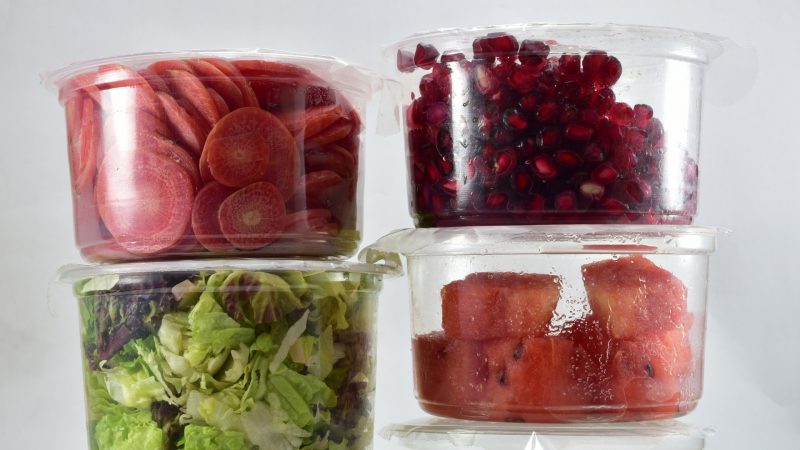
Use food storage boxes that can be sealed tightly. Any opened items, from cereal and bread to candy and cookies, should be stored in air-tight containers. If possible, store fruits and vegetables in the refrigerator, even if they have not yet been cut.
2. Clean up Crumbs and Spills Immediately
Check the floor and countertops for spills or crumbs each time you prepare a meal or grab something to eat. Even a few crumbs or drops of juice on the countertop can be enough to attract ants.
3. Do the Dishes After Each Meal
It’s very tempting sometimes to put off doing the dishes until later. But the truth is, the food left on dirty dishes can look great to an ant scouting for food. As much as possible, clean the dishes as soon as you finish eating.
4. Take the Trash out Regularly
Trash cans are full of food residue, bringing ants into your kitchen. Even a trash can with a lid won’t prevent these critters from finding their way in. So, if your kitchen is prone to ant problems, get rid of your garbage daily.
5. Don’t Leave Left Over Pet Food Sitting Out
Ants will often go for pet food as they’re not particularly picky and it’s always conveniently placed in the same spot. After your pet has eaten, discard any remaining food and clean the bowl to ensure no crumbs are left behind.
Related: How to Get Rid of Ants | Safe and Effective Methods
List of Sources
Allsup, K. (2019). Ants in the Kitchen.
Davis, R. S., Spears, L., & Taylor, A. (2020). Pavement Ants.
Hurley, J. (2011). Got ants in your pantry? Tiny ants can be big bother to many South Central Texas homeowners.
Jesse, L. (2005). Ants in the kitchen.
Máximo, H. J., Felizatti, H. L., Ceccato, M., Cintra-Socolowski, P., & Beretta, A. L. (2014). Ants as vectors of pathogenic microorganisms in a hospital in São Paulo county.
Nickerson, J. C., Harris, D. L., & Fasulo, T. R. (2021). Pharaoh Ant.
Texas A&M AgriLife Extension Service. (2011). Got ants in your pantry?
University of California. (n.d.). Managing ants with baits
Vail, K. (n.d.). Carpenter Ants – Those Big Ants in Your Kitchen and Bathroom.
- Bed Bug Surge 2025: How to Detect, Prevent, and Safely Eliminate Infestations in Top U.S. Cities - June 18, 2025
- Asian Needle Ants Invade US Homes: 2025 Guide to Identification, Risks, and Effective Control - June 11, 2025
- New World Screwworm Alert: How US Livestock Owners Can Prevent Outbreaks and Protect Herds [Summer 2025 Update] - June 8, 2025





